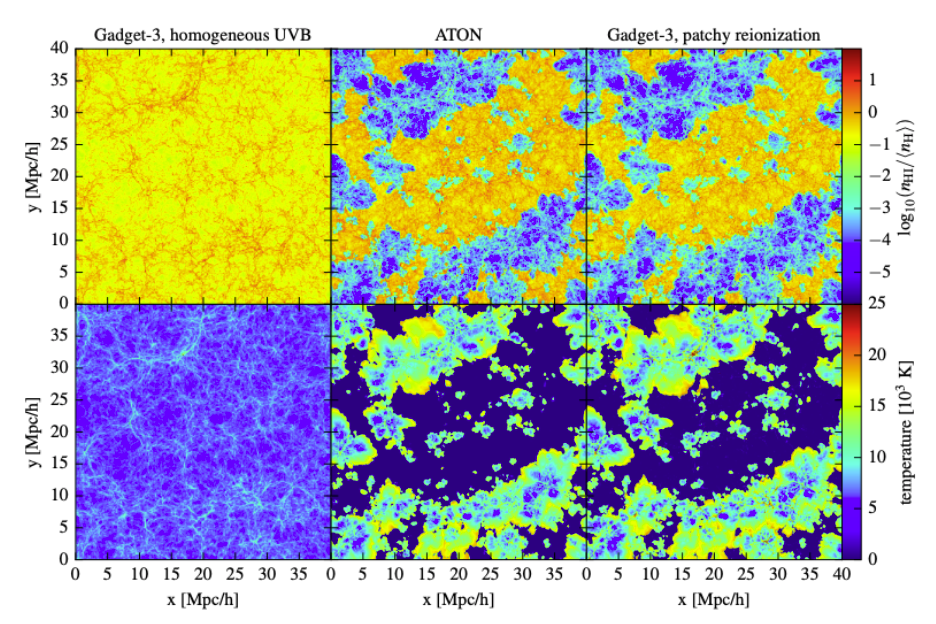The intergalactic medium (IGM) - observed primarily in
absorption in the spectra of luminous quasars - represents the
largest repository of baryons in the Universe. It is an
excellent probe of the thermal and ionisation state of
intergalactic gas over a vast swathe of cosmic time, stretching
all the way from the local Universe at z~0 to the epoch of
reionisation
at redshifts z>5. It is, furthermore, an unrivalled tracer of
the structure of the cosmic web on scales of ~10-100 comoving
kpc that is probed observationally by the
Lyman-alpha
forest. Over the last few years, our team of researchers
have used
the
Sherwood
simulation suite to address a wide range of open questions
pertaining to reionisation, the IGM and the "small-scale crisis"
of
cold
dark matter. However, a limitation of Sherwood was that it
assumed a pre-computed, spatially
homogeneous
ultraviolet
background for heating and ionising the baryons in the IGM.
This approach neglects the large-scale fluctuations in the
ionisation state of intergalactic gas expected approaching the
reionisation epoch. This limits the utility of our simulations
when interpreting the Lyman-alpha forest at z>5 in the context
of reionisation models. It has also been argued that neglecting
ionisation and thermal fluctuations in IGM simulations could
weaken existing Lyman-alpha forest constraints on the free
streaming length of dark matter, leaving the door open for
alternatives to cold dark matter.
The Sherwood-Relics simulations redress this situation by
including a self-consistent model for
cosmological
radiative
transfer. This enables us to properly include the effect of
the inhomogeneous nature of reionisation on the thermal and
ionisation history of the IGM, to explore a wider range of
reionisation histories, and to push our accurate modelling of
Lyman-alpha forest data toward the reionisation era at z
>5. This is crucial for further
improving
measurements
of the free streaming of dark matter, as well as constraining
the
thermal state
of the IGM. We achieve this through a combination
of
P-Gadget-3
cosmological hydrodynamical simulations and radiative transfer
simulations performed with the GPU accelerated
code
ATON. A major
advantage of our novel "hybrid radiation-hydrodynamics" approach
is that we use well-calibrated models of patchy reionisation
obtained with ATON to construct hydrodynamical simulations that
are fully coupled to the thermal pressure associated with
inhomogeneous IGM heating. This approach provides consistent IGM
temperatures and pressure smoothing for these patchy
reionisation models. With Sherwood-Relics, we are therefore able
to
accurately
model
the IGM both during and after reionisation at the mass
resolution required for correctly capturing the properties of
the Lyman-alpha forest.
The image above shows the neutral hydrogen density (top panels)
and gas temperature (bottom panels) in one of the
Sherwood-Relics simulations assuming either a homogeneous UV
background (left, following the approach used in our earlier
Sherwood project),
a UV background obtained with cosmological radiative transfer
applied in post-processing using ATON (middle), and the new
hybrid radiation-hydrodynamics approach we have developed for
Sherwood-Relics (right). The hybrid model has a similar
structure of ionised and neutral regions compared to the
post-processed model, but crucially it also accounts for the
shock-heating of gas in high density regions, self-consistently
captures the smoothing of the gas distribution by thermal
pressure, and follows the advection of thermal energy in the gas
flows.
The Sherwood-Relics simulations were performed with a modified
version of the cosmological smoothed particle hydrodynamics code
P-Gadget-3, developed
by
Volker Springel. P-Gadget-3 is an updated and extended
version of the publicly
available
Gadget-2
code. The cosmological radiative transfer in Sherwood-Relics
was followed the moment-based, M1-closure
code
ATON,
developed
by
Dominique
Aubert. The 50 million hours of supercomputer time used to
run the Sherwood-Relics simulations was awarded through
the
PRACE (Partnership
for Advanced Computing in Europe) 16th regular access call, and
the 12th call of the UK's
DiRAC (Distributed Research
using Advanced Computing) facility. Funding was also provided
by
The Royal Society,
the
Science and Technology
Facilities Council (STFC) and the
European Research Council
(ERC).
